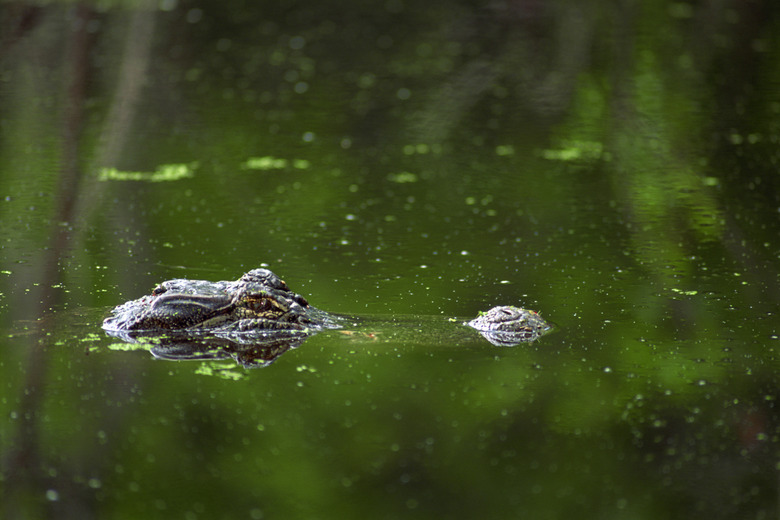Ecosystem Diversity In Louisiana
From alligator- and bear-prowled swamps to shark-cruised bays and seabird rookeries, Louisiana showcases impressive ecological diversity — an environmental richness mirroring its beautifully jumbled-together human culture. Encompassing the vast, convoluted mouth of North America's greatest drainage, the Mississippi River, the state is notable for its expanses of wild wetlands, but timbered hollows and upland savannas are also part of its natural character.
Geographic Overview
Geographic Overview
Louisiana's physical terrain, in conjunction with its humid-subtropical climate, provides a foundation for its sundry panoply of ecosystems. At the broadest scale, all of the state belongs to the Atlantic-Gulf Coastal Plain, which eases gently seaward. More specifically, the hilly-to-level uplands of the South Central Plains cover northwestern and west-central Louisiana; the bottomlands, terraces and bluffs of the Mississippi River system dominate eastern and southeastern Louisiana, extending into a great bird's-foot delta in the Gulf of Mexico.
Uplands
Uplands
Louisiana's subdued uplands include a range of forest, savanna, grassland and wetland ecosystems. Among the more distinctive are the eastern red-cedar woodlands of the calcareous, or lime-rich, Jackson Formation in north-central Louisiana. Far more widespread, especially historically, are savannas of longleaf pine, one of the defining ecological landscapes of the southern Atlantic-Gulf Coastal Plain. Alkaline soils support airy oak groves and grassy salt barrens, while rough ravine slopes are cloaked in rich hardwood forests of beech, oak, sweetgum, magnolia and hickories.
Lowlands
Lowlands
Much of Louisiana is sodden bottomland, from floodplain swamp to flatwoods ponds and glimmering marshlands. Among the most extensive such communities is the baldcypress-tupelo swamp, common along river channels but also poorly drained depressions and swales. Some of the greatest remaining tracts in the country reside in the Atchafalaya Basin, which also boasts huge expanses of freshwater marsh. American alligators, anhingas, water moccasins, egrets, gars, turtles, muskrats — life in Louisiana bottomlands throbs with diversity.
Coastal and Marine
Coastal and Marine
Louisiana's coastal habitats include salt marshes, coastal prairies and maritime forests — including the live-oak hammocks thriving atop "cheniers," former beach ridges fronting the coastline in southwestern Louisiana. Mangrove shrub-swamps grow on the estuarine fringes of the Deltaic Plain of southeastern Louisiana, composed of stunted black mangroves — larger and more widespread in Florida — on the northern fringe of their natural range. Nearshore communities include lush seagrass beds, important foraging ground for such rare marine creatures as sea turtles and manatees.
References
- Louisiana Wildlife and Fisheries: Natural Communities of Louisiana — Cedar Woodlands
- Louisiana Wildlife and Fisheries: Natural Communities of Louisiana — Western Upland Longleaf Pine Forest
- Louisiana Wildlife and Fisheries: Natural Communities of Louisiana — Saline Oak Woodland
- Coastal Wetlands Planning, Protection and Restoration Act: The Atchafalaya Basin
- Louisiana Wildlife and Fisheries: Natural Communities of Louisiana — Coastal Mangrove
- Louisiana Wildlife and Fisheries: Natural Communities of Louisiana — Submergent Vascular Vegetation
Cite This Article
MLA
Shaw, Ethan. "Ecosystem Diversity In Louisiana" sciencing.com, https://www.sciencing.com/ecosystem-diversity-louisiana-6572/. 24 April 2017.
APA
Shaw, Ethan. (2017, April 24). Ecosystem Diversity In Louisiana. sciencing.com. Retrieved from https://www.sciencing.com/ecosystem-diversity-louisiana-6572/
Chicago
Shaw, Ethan. Ecosystem Diversity In Louisiana last modified August 30, 2022. https://www.sciencing.com/ecosystem-diversity-louisiana-6572/
